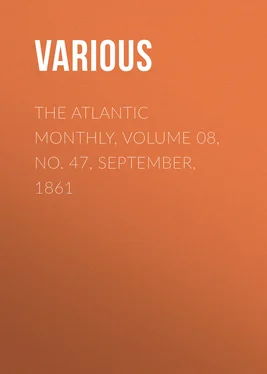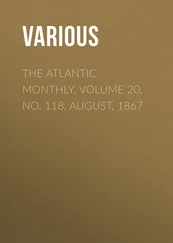Various - The Atlantic Monthly, Volume 08, No. 47, September, 1861
Здесь есть возможность читать онлайн «Various - The Atlantic Monthly, Volume 08, No. 47, September, 1861» — ознакомительный отрывок электронной книги совершенно бесплатно, а после прочтения отрывка купить полную версию. В некоторых случаях можно слушать аудио, скачать через торрент в формате fb2 и присутствует краткое содержание. Жанр: foreign_antique, periodic, foreign_edu, на английском языке. Описание произведения, (предисловие) а так же отзывы посетителей доступны на портале библиотеки ЛибКат.
- Название:The Atlantic Monthly, Volume 08, No. 47, September, 1861
- Автор:
- Жанр:
- Год:неизвестен
- ISBN:нет данных
- Рейтинг книги:4 / 5. Голосов: 1
-
Избранное:Добавить в избранное
- Отзывы:
-
Ваша оценка:
- 80
- 1
- 2
- 3
- 4
- 5
The Atlantic Monthly, Volume 08, No. 47, September, 1861: краткое содержание, описание и аннотация
Предлагаем к чтению аннотацию, описание, краткое содержание или предисловие (зависит от того, что написал сам автор книги «The Atlantic Monthly, Volume 08, No. 47, September, 1861»). Если вы не нашли необходимую информацию о книге — напишите в комментариях, мы постараемся отыскать её.
The Atlantic Monthly, Volume 08, No. 47, September, 1861 — читать онлайн ознакомительный отрывок
Ниже представлен текст книги, разбитый по страницам. Система сохранения места последней прочитанной страницы, позволяет с удобством читать онлайн бесплатно книгу «The Atlantic Monthly, Volume 08, No. 47, September, 1861», без необходимости каждый раз заново искать на чём Вы остановились. Поставьте закладку, и сможете в любой момент перейти на страницу, на которой закончили чтение.
Интервал:
Закладка:
In the present case reasons have been given by Sir Frederic Madden, Mr. Hardy, and Dr. Ingleby, the chief-justice and two puisne judges of our court. The first says, (in his letter of March 24th, 1860, to the London "Critic,") that, on examining the folio with Mr. Bond, the Assistant Keeper of his Department, they were both "struck with the very suspicious character of the writing,"—certainly the work of one hand, but presenting varieties of forms assignable to different periods,—the evident painting of the letters, and the artificial look of the ink.
Mr. Hardy speaks more explicitly to the same purpose; and we must quote him at some length. He says,—
"The handwriting of the notes and alterations in the Devonshire folio [Mr. Collier's] is of a mixed character, varying even in the same page, from the stiff, labored Gothic hand of the sixteenth century to the round text-hand of the nineteenth, a fact most perceptible in the capital letters. It bears unequivocal marks also of laborious imitation throughout.
"In their broader characteristics, the features of the handwriting of this country, from the time of the Reformation, may be arranged under four epochs, sufficiently distinct to elucidate our argument:—
"1. The stiff upright Gothic of Henry VIII. and Edward VI.
"2. The same, inclining and less stiff, as a greater amount of correspondence demanded an easier style of writing, under Elizabeth.
"3. The cursive, based on an Italian model, (the Gothic becoming more flexible and now rapidly disappearing,) in the reign of James I., and continuing in use for about a century.
"4. The round hand of the schoolmaster, under the House of Hanover, degenerating into the careless, half-formed hands of the present day.
"Now it is perfectly possible that any two of these hands in succession may have been practised by the same person…. That the first and third or the second and fourth should be coexistent is very improbable. That all, or that the first, second, and fourth, should be found together, as belonging to one and the same era, we hold to be utterly impossible.
"Yet this is a difficulty that Mr. Collier has to explain; as the handwritings of the MS. corrections in the Devonshire folio, including those in pencil, vary as already said, from the stiff, upright, labored, and earlier Gothic, to the round text-hand of the nineteenth century." 18 18 A Review , etc., pp. 6, 7.
On this point Dr. Ingleby says, succinctly and decidedly, "The primal evidence of the forgery lies in the ink writing, and in that alone"; 19 19 A Complete View , p. 114.
but he expressly bases this dictum upon the decisions of the professed palaeographers of the British Museum and the Record Office. He goes on, however, to assign important collateral proof of the forgery, both of the readings in the folio and the documents brought forward by Mr. Collier, by connecting them with each other. Thus he says, that whoever will compare the fac-similes of the document known as "The Certificate of the Blackfriars Players" with those which he gives of two passages in the folio "will surely entertain no doubt that one hand wrote both." 20 20 Ib. p. 250.
He expresses also the same confidence that "there can be but one intelligent opinion" that another important document, known as "The Blackfriars Petition," was, as Mr. Hamilton believes, "executed by the same hand" as that to which we owe the Certificate, and, consequently, the folio readings. 21 21 Ib. p. 293.
Again, with regard to another of these documents, known as "The Daborne Warrant," Dr. Ingleby says,—"Mr. Hamilton remarks, what must be plain to every one who compares the fac-simile of the Daborne Warrant with those of the manuscript emendations in the Perkins folio, that the same hand wrote both. In particular the letters E, S, J, and C are formed in the same peculiar pseudo-antique manner." 22 22 Ib. p. 256.
And finally, Mr. Hamilton decides, and Dr. Ingleby concurs with him, that a certain List of Players appended to a letter from the Council to the Lord Mayor, in which Shakespeare's name stands third, is "done by the same hand" which produced the professed contemporary copy of a letter signed H.S. about Burbage and Shakespeare, supposed to be from the Earl of Southampton. Giving his reason for this opinion, Dr. Ingleby says,—"Among other similarities in the forms of the letters to those characterizing the H.S. letter, is the very remarkable g in 'Hemminges'." 23 23 Ib. p. 271.
Let us examine the alleged grounds of these decisions,—"the varieties of forms assignable to different periods," and the extension of those varieties "from the stiff, labored Gothic hand of the sixteenth century to the round-text hand of the nineteenth." This judgment is passed upon all the writing on the margins of the folio, including the pencil memorandums. For the present we shall set aside the latter,—the pencil memorandums,—as not properly belonging to this branch of the subject. For this pencil writing, although it has a most important bearing upon the question of the good faith of the marginal readings, has no professed character, antique or modern: it is, of course, not set forth directly or indirectly, either by the unknown writer of the marginalia, or by Mr. Collier, as evidence of the date at which they were made. And as, according to Dr. Ingleby, "the primal evidence of the forgery lies in the ink writing, and in that alone," with that alone we shall at present concern ourselves. As the careless, half-formed hand of the present day, degenerate from "the round hand of the school-master," appears only in the pencil writing, we have therefore to deal but with the first three styles of writing enumerated by Mr. Hardy; and as he himself admits that "it is perfectly possible that any two of these hands in succession may have been practised by the same person," if those who maintain the side of forgery fail to show that "the stiff upright Gothic of Henry VIII. and Edward VI." appears upon the margins of this folio, we shall only have the second and third styles enumerated by Mr. Hardy, i.e., the hands of Elizabeth and James I., to take into consideration; and the so-called "primal evidence of the forgery," in the "varieties of forms assignable to different periods," falls to the ground.
Now it is most remarkable, that, among all the numerous fac-similes of the writing in this volume which have been published either by Mr. Collier himself, or by his opponents, with the very purpose of proving the forgery, not a word or a letter has appeared in a hand which was not in common use from the latest years of Elizabeth's reign, through James I.'s and Charles I.'s, down through the Commonwealth to and well past the time of the Restoration,—a period, be it remembered, of only between fifty and seventy-five years. We are prepared to show, upon the backs of title-pages and upon the margins of various books printed between 1580 and 1660, and in copy-books published and miscellaneous documents dated between 1650 and 1675, writing as ancient in all its characteristics as any that has been fac-similed and published with the purpose of invalidating the genuineness of the marginal readings of Mr. Collier's folio.
We are also prepared to show that the lack of homogeneousness (aside from the question of period or fashion) and the striking and various appearance of the ink even on a single page, which have been relied upon as strong points against the genuineness of the marginal readings, are matters of little moment, because they are not evidence either of an assumed hand or of simulated antiquity; and even further, that the fact that certain of the pencilled words are in a much more modern-seeming hand than the words in ink which overlie them is of equally small importance in the consideration of this question. Our means of comparison in regard to the folio are limited, indeed, but they are none the less sufficient; for we may be sure that Mr. Collier's opponents, who have followed his tracks page by page with microscopes and chemical tests, who hang their case upon pot-hooks and trammels, and lash themselves into palaeographic fury with the tails of remarkable g -s, have certainly made public the strongest evidence against him that they could discover.
Читать дальшеИнтервал:
Закладка:
Похожие книги на «The Atlantic Monthly, Volume 08, No. 47, September, 1861»
Представляем Вашему вниманию похожие книги на «The Atlantic Monthly, Volume 08, No. 47, September, 1861» списком для выбора. Мы отобрали схожую по названию и смыслу литературу в надежде предоставить читателям больше вариантов отыскать новые, интересные, ещё непрочитанные произведения.
Обсуждение, отзывы о книге «The Atlantic Monthly, Volume 08, No. 47, September, 1861» и просто собственные мнения читателей. Оставьте ваши комментарии, напишите, что Вы думаете о произведении, его смысле или главных героях. Укажите что конкретно понравилось, а что нет, и почему Вы так считаете.












